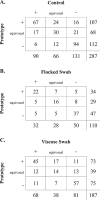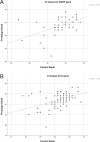Low-Cost Polyester-Tipped Three-Dimensionally Printed Nasopharyngeal Swab for the Detection of Severe Acute Respiratory Syndrome-Related Coronavirus 2 (SARS-CoV-2)
- PMID: 32817232
- PMCID: PMC7587115
- DOI: 10.1128/JCM.01668-20
Low-Cost Polyester-Tipped Three-Dimensionally Printed Nasopharyngeal Swab for the Detection of Severe Acute Respiratory Syndrome-Related Coronavirus 2 (SARS-CoV-2)
Abstract
Case identification, isolation, and contact tracing are fundamental strategies used to control the spread of coronavirus disease 2019 (COVID-19). This has led to widespread testing that interrupted the supply chain for testing materials around the world. A prospective study was conducted to compare inexpensive and easily sourced 3-dimensionally (3D)-printed polylactic acid and polyester nasopharyngeal swabs to commercially manufactured swabs for the detection of severe acute respiratory syndrome-related coronavirus 2 (SARS-CoV-2). During the study period, 287 laboratory-confirmed hospitalized COVID-19 patients, at multiple stages of their illness, were enrolled. The median age for the study population was 47.6 years (interquartile range [IQR], 34.4 to 56.6 years), and two-thirds (67.6%) of the subjects were male. The median duration of hospitalization, at the time of sampling, was 13 days (IQR, 10 to 16 days). Overall concordance between the prototype and control swabs was 80.8% (Cohen's kappa coefficient, 0.61). Most discrepant results were due to prototype-positive control-negative results. When considering all positive results to be true positives, the prototype swab had a higher sensitivity (90.6% versus 80.8%; 95% confidence interval [CI], 85.7% to 94.0% and 74.7% to 85.7%, respectively; P < 0.015). The cost to produce the prototype swab was estimated to be $0.05 per swab. Polylactic acid 3D-printed polyester-tipped swabs were shown to be effective for nasopharyngeal sample collection. We believe that this design can easily be adopted in countries where commercial swabs are not readily available and can play a vital role in public health efforts for disease control in low-income countries.
Keywords: COVID-19; nasopharyngeal; swab.
Copyright © 2020 American Society for Microbiology.
Figures




References
Publication types
MeSH terms
Substances
LinkOut - more resources
Full Text Sources
Other Literature Sources
Medical
Miscellaneous

